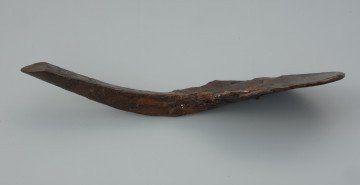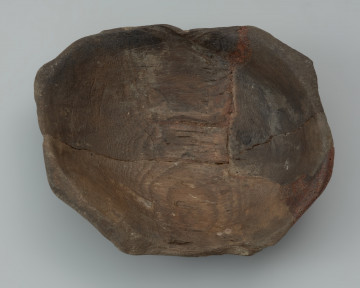
Spoon
National Museum in Szczecin
Part of the collection: Middle Ages
Early medieval households used a range of clay and wooden vessels. There were lathe-turned cups and bowls and coopers' products such as buckets, jars, bowls and pans made of different-sized staves among wooden vessels. Another group of vessels is formed by shallow basins hollowed out of split trunks of deciduous trees, e.g. linden, willow or poplar. They were usually equipped with handles for easier carrying. In reconstructing the function of these vessels, the results of ethnographic research are particularly helpful, as they show that every household had several basins of various sizes, intended for washing laundry, washing up, storing meat and even for rocking children. A wooden basin called a kneading trough is most often associated with kneading dough for baked goods. In folk tradition, the kneading trough was held in high esteem as a bread vessel. During marriage ceremonies, the bride and groom were seated on a bowl turned upside down. The best bread trough was the one-handed down from generation to generation. It was not lent to neighbours, it should not have fallen to the ground, and it should not have been made from wood struck by lightning. In some regions of Poland, a kneading trough was used in magic and medicine.
Anna Bogumiła Kowalska
Other names
bowl
Author / creator
Dimensions
cały obiekt: height: 23.1 mm, width: 33.6 mm
Object type
pan, haus furnishing
Technique
boring, hand made, individual
Material
wood
Origin / acquisition method
field research
Creation / finding place
Owner
Muzeum Narodowe w Szczecinie
Identification number
Location / status

National Museum in Szczecin

900 — 1250
National Museum in Szczecin

700 — 1250
National Museum in Szczecin
DISCOVER this TOPIC
National Museum in Szczecin
DISCOVER this PATH
Educational path